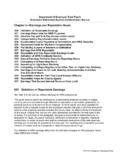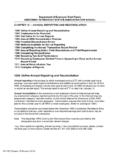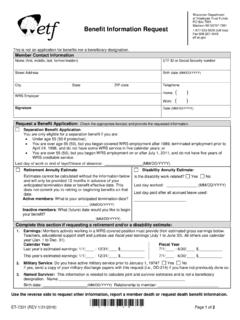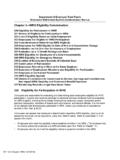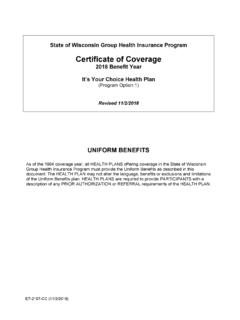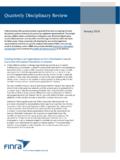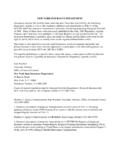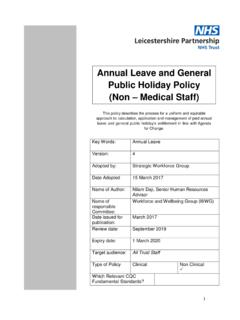Transcription of How Participation In the Variable Trust Fund Affects …
1 How Participation In the Variable Trust Fund Affects Your WRS Benefits ET-4930 (REV 10/2014) Scan to read online. TABLE OF CONTENTS. How WRS Retirement Annuities are How Variable Trust Fund Participation Affects Your Retirement Variable Trust Fund Adjustments to Monthly How to Elect Variable Trust Fund How to Cancel Variable Trust Fund Election to Participate in the Variable Trust Fund (ET-2356) Canceling Variable Participation (ET-2313) History Core and Variable Trust Funds for each of the state retirement systems (the former State Teachers Retirement System, Milwaukee Teachers Retirement Fund and Wisconsin Retirement Fund) were established by Chapters 381 and 423, Laws of 1957 effective January 1, 1958. Effective January 1, 1982, these retirement systems were legally merged into one retirement system: the Wisconsin Retirement System, which is administered by the Department of Employee Trust Funds.
2 The Variable Trust Fund was created to establish a well balanced, broadly diversified investment program that would provide retirement benefits that would fluctuate as the value and earnings of investments vary, in proportion to changes in the general economy. When the Variable Trust Fund was established, it was anticipated that greater utilization of equity investments would result in the accumulation of larger deposit reserves during a participant's working years, tend to preserve the purchasing power of the deposits made and benefits provided and provide better protection during periods of inflation. However, those who elect this option risk the possibility that unfavorable stock market performance will result in losses.
3 At the time the Variable Trust Fund was established, the Core Trust Fund (formerly called the Fixed Trust Fund) was invested entirely in bonds and other fixed income securities. A majority of the Core Fund is now invested in stock, but it also includes a mixture of other assets. As a result, it is considered a fully diversified and balanced fund. Originally, all contributions were deposited into the Core Trust Fund. From 1957 to 1980, participants could elect to join the Variable Trust Fund. At that time, an election to join the Variable program was irrevocable. Once the election to join the Variable program was effective, 50% of employee contributions and an equal dollar amount of employer contributions were deposited into the Variable Trust Fund; the remaining 50% was deposited into the Core Trust Fund.
4 A law change closed the Variable Trust Fund to further enrollments effective April 29, 1980, and allowed existing Variable participants to cancel their Variable Participation . The Variable Trust Fund was re-opened to new enrollments effective January 1, 2001. If you elect to participate in the Variable Trust Fund, 50% of all future contributions (employee, employer and additional). will be deposited in the Variable Trust Fund. The election applies to future contributions only;. you cannot transfer existing balances into the Variable Trust Fund. To elect Variable Trust Fund Participation , you must file an Election to Participate in the Variable Trust Fund (ET-2356) form with ETF (see Page 9). Participants who elect to join the Variable Trust Fund remain in that program unless they elect to cancel their Participation by filing a Canceling Variable Participation (ET-2313) form with ETF.
5 (see Page 12). Once you cancel Variable Trust Fund Participation , there is no opportunity to rejoin unless you completely close your WRS account by withdrawing your account balance and later return to work for a WRS-participating employer. By becoming a new participating employee, you have a new Variable election option. 1. How WRS Retirement Annuities Are Calculated There are two methods of calculating retirement benefits: the formula and money purchase methods. By law, the WRS always pays the higher of these two calculations. Formula Benefit A formula retirement benefit is calculated by multiplying your final average monthly earnings, the formula factor(s) for your employment category(ies) in pre-2000, post-1999 and post-Act 10 years, your years of creditable service, and any applicable age reduction factor if you are retiring before your normal retirement age.
6 This calculation provides your monthly formula annuity option (For Annuitant's Life Only), before any adjustment (either positive or negative). is made based on your Variable Trust Fund Participation . The amount of your annuity may also be adjusted based on the annuity option that you select. 1999 Wisconsin Act 11 increased the formula multipliers for creditable service performed before 2000. The formula multiplier remains at the pre Act 11 levels for WRS-creditable service performed after 1999. To be eligible for this improved formula factor, a participant must be actively employed under the WRS after 1999. 2011 Wisconsin Act 10 decreased the formula multiplier for participants in the Executive/Elected Official category.
7 Formula multipliers for other categories remain the same. Employment Category Pre-2000 Service Post-1999 Service Post-Act 10 Service General Employees and Teachers Protectives with Social Security Protectives without Social Security Elected Officials & State Executive Retirement Plan Employees To calculate a formula retirement benefit for participants who have creditable service in different periods (pre-2000, post-1999 and post-Act 10), ETF will determine the amount of creditable service in each period and multiply each by the appropriate formula factor, the final average earnings and any age reduction factor. The pre-2000, post-1999 and post-Act 10 formula sums are added together for the total monthly formula annuity for the option For Annuitant's Life Only.
8 If the participant has ever participated in the Variable Trust Fund, a Variable adjustment will be made to the initial annuity amount. Example A Basic Formula-All Core: Participant is 65 years old and has a final average earnings of $2,150. The participant has 32 years of creditable service in the general category; 30 years of service earned prior to 2000 (pre-2000) and 2 years of service earned after 1999 (post-1999). There is no applicable age reduction factor for this participant. This participant's all Core formula annuity is calculated as follows. Final Average Earnings Formula Factor Years of Service Formula Annuity $2,150 X .01765 (pre-2000) X 30 = $1, $2,150 X .016 (post-1999) X 2 = + $ Total Formula Annuity $1, Option for Annuitant's Life Only 2.
9 Money Purchase Benefit A money purchase retirement benefit is calculated by multiplying the money purchase balance in your WRS account (plus accrued interest) by a money purchase factor based on your age and your benefit effective date. You can find your money purchase balance on your annual Statement of Benefits. This calculation provides your monthly money purchase annuity option (For Annuitant's Life Only) before any reduction based on the annuity option you select. How Variable Trust Fund Participation Affects Your Retirement Annuity Variable Trust Fund Participation Affects your retirement benefit differently for formula and money purchase benefits. If your benefit is higher under the money purchase calculation method, the Core and Variable balances in your account are each multiplied by the money purchase factor for your age.
10 This produces the Core and Variable portions of your For Annuitant's Life Only annuity option. The Core and Variable portions of your annuity will be in direct proportion to the amounts in your Core and Variable accounts. If your benefit is higher under the formula calculation method, a Variable adjustment is made to your annuity based on the Variable excess or Variable deficiency as of January 1, in the year your annuity begins. This Variable excess or deficiency amount is based on a comparison of the actual balance of your account versus what your account balance would be if your contributions had been invested only in the Core Trust Fund. The actual dollar amount of the Variable excess or deficiency in your account will change each year, based on the investment experience of the Core and Variable Trust Funds.
